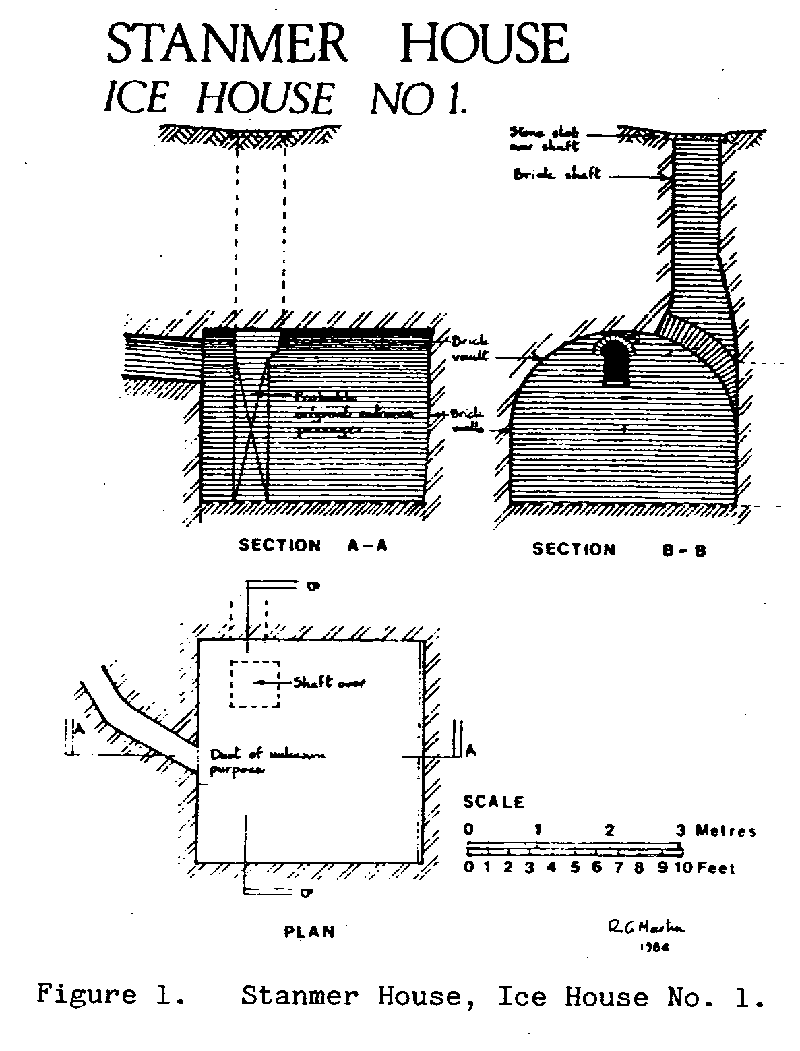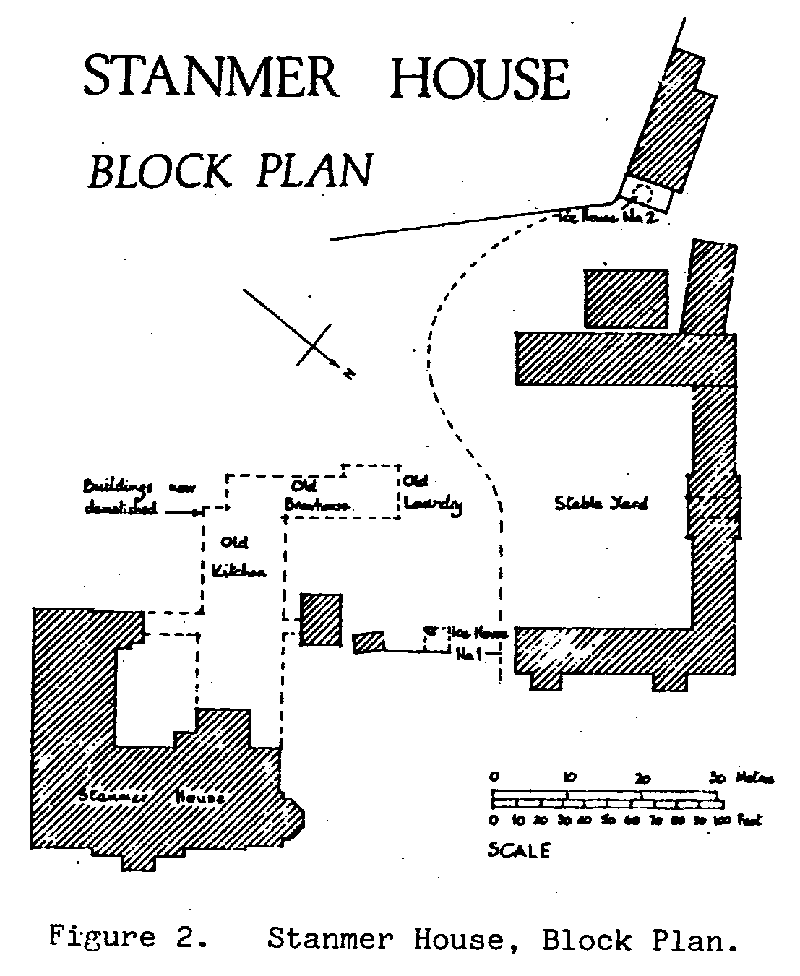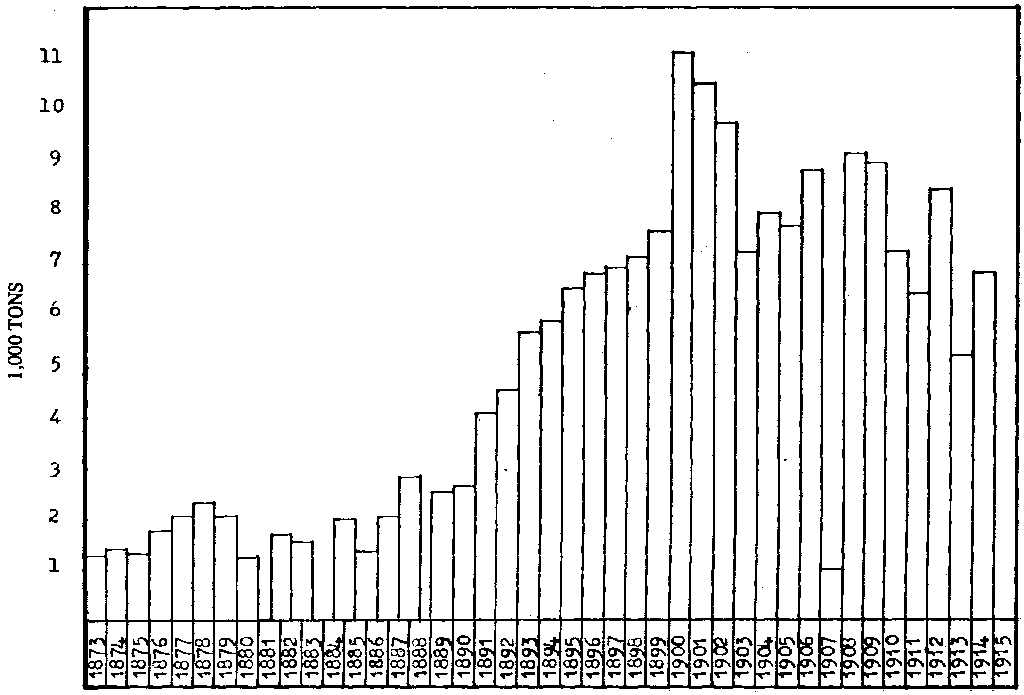ICE HOUSES AND THE COMMERCIAL ICE TRADE IN BRIGHTON
R.G. Martin
In Britain the practice of storing ice in specially constructed chambers was
started in the 17th century and continued up to the early 20th century. At first
ice was collected exclusively from local ponds and lakes and was placed in the
private Ice Houses of large estates where, if properly insulated, it would last
the year through. These Ice Houses were usually built partly or wholly below
ground, typically with a cylindrical pit of about 3 metres in diameter and 6
metres deep with a domed top. An entrance passage, horizontal or with steps
leading down was often used for access and occasionally a loading shaft through
the top. Materials used were usually brick but other local materials such as
clunch, sandstone and flint rubble were also used. An Ice House of a much larger
character at Petworth House was described in Sussex Industrial History No. 13,
(1983), pp. 15 - 21 by the author. The expressions 'Ice Well' and 'Ice House'
are synonymous.
Within the present Borough of Brighton there were several private Ice Houses
that are known to date from the 18th or early 19th century, as follows
Ice House in Chalk Pit at top of North Street (TQ 307044)
The chalk pit in which the Ice House ws situated was first shown on the map
surveyed in 1779 by Yeakell and Gardneri The land which had previously been
owned by Nathaniel Kemp was bought by L. Weltje, the Prince of Wales's steward,
who leased it to the Prince in 1788. The Ice House was presumably built at about
this time as in 1789 it was referred to as "new-erected building called an
Ice House with Tea Room and Summer House over", 2 An extant plan which was
prepared when the adjacent land was offered for sale in 1818 shows the precise
location of the Ice House. 3 It is known that two Ice Wells were rebuilt by the
Prince Regent in 1823 and it is presumed that these were the Ice House noted
above and that at the Royal Pavilion described later.
Between 1830 and 1867 there was no access to the Ice House
from North Street and the address given in the Directories is Regent Row, a
small alley between North Street and Regent Hill. In 1869 and 1874, the site was
called 'Pocock's Ice Store', in 1878 'Pocock and Steven's Royal Ice Store' and
in 1879 'The Kent and Sussex Ice Store'. 4 In 1874 the Rate Books describe the
site as "Ice Well and Stabling", stating the owner as Brighton Council
and the occupier as Henry Pocock and in 1884 as James Horton Stephens. Although
these entries in the Rate Books are for 961 North Street they were doubtless
referring to the same site. 5
From 1879 to 1903 the site was known as 96a North Street and
was located on the east side of Regent Row. The occupier throughout this period
being the Kent and Susex Pure Ice Company'. It is probable that offices for the
company-were built on the North Street frontage in front of the Ice House, the
access to the Ice House still being from Regent Row. The site is currently
occupied by Messrs. Gamleys.
From 1879 onwards the 'Kent and Sussex Pure Ice Company' had a
factory in Portland Road, Porislade, 6 and between 1887 and 1890 also had
premises at No. 106 North Street.
Royal Pavilion Ice House (TQ 3114 0424)
An Ice House owned by the Prince Regent was situated
at the south-west corner of the Royal Pavilion grounds. During excavations in
1956 it was uncovered, several feet below ground, and was described as having a
domed brick roof. 7 Its location is shown on the plan of the Royal Pavilion
estate by John Nash in 1822. 8 This part of the grounds, previously known as
Furner's Gardens, was acquired by the Prince during 1804. 9 Presumably the Ice
House was subsequently built by the Prince and that this was one of the two Ice
Wells that were rebuilt in 1823.
Castle Tavern Ice House (TQ 312041)
The Prince Regent also acquired another Ice House when
he bought a quarter part of the Castle Tavern which included an Ice House. 10
This was probably demolished in 1821 when the Royal Pavilion was reconstructed
by John Nash.
Stanmer House Ice Houses (TQ 3349 0948 and TQ 3343 0946)
The only extant Ice House in Brighton is at Stanmer
House, shown in Figures 1 and 2. It is a small square brick chamber with a brick
barrel vault. Access is through a vertical brick shaft 2.7 metres deep although
there are indications of another entrance, now bricked up. This could have led
towards the, now demolished, service wing of the house. There are remains of a
lead lining to the walls of the chamber also a high level duct leading
southwards. It is probable that this Ice House was originally constructed for
some other purpose, possibly in connection with the water supply system which
was very extensive, otherwise there is no reasonable explanation for the depth
of the structure below ground and of the other features mentioned above.
Another Ice House on the estate, is described as circular on
plan, 2 metres in diameter and approximately 5 metres deep, with a domed brick
roof rendered internally and with access through the top. This has now been
back-filled and concreted over!'
Estate workers report that both Ice Houses were used until
shortly before the First World War and that ice from the estate was used in the
house and also carted into Brighton for sale. 11


(Select view image in your browser for a larger view)
The Commercial Ice Trade up to 1854
During the first half of the 19th century the increase in numbers of middle
and upper class residents and visitors to the town created a demand for ice and
a commercial ice trade developed to cater for this. The sources of supply of
this ice are uncertain but there might well have been active trading down the
east coast of England from the Norfolk Broads. It is known that ice was being
imported into London from Norway by the 1850s. 12 There are no obvious local
sources to satisfy such a demand. Old Steine was reputedly marshy until drained
in 1792, Queen's Park Lake was not created until the 1880s and apart from
several small ponds at Falmer, Rottingdean and in Stanmer Park, the only other
local stretches of open water were storage reservoirs. In 1962, when an
electricity substation was being erected close to the Islingword Road Reservoir
(at TQ 322050) a structure was discovered and from drawings prepared at that
time, this appears to have been a large Ice House. 13 Its juxtaposition to the
reservoir suggests that ice was taken therefrom, but as the level of the water
would have been fluctuating daily, the formation of ice on the surface would
have been inhibited.
There were Ice Houses in Brighton during the first half of the nineteenth
century at the following locationsc:
| No. 14 Henry Street |
(TQ 314043) |
1834 - 1836 |
| No. 4 Upper Church Street |
(TQ 307045) |
1839 - 1844 |
| No. 36 Russell Street |
(TQ 306041) |
1839 - 1854 |
| No. 42 New Dorset Street |
(TQ 306046) |
1839 - 1854 |
| No. 12 St. James's Gardens |
(TQ 314041) |
1834 - 1844 |
| No. 4 Centurion Place |
(TQ 307045) |
1840 - 1844 |
| No. 3 Centurion Place |
(TQ 307045) |
1854 |
| No. 11 Powis Grove |
(TQ 305047) |
1854 |
| No. 16 William Street |
(TQ 314043) |
1854 |
The Commercial Ice Trade, 1854 - 1915
During the second half of the 19th century and more
particularly after the 1870s, when ice was being imported, there was a
proliferation of Ice Merchants in Brighton. It is significant that these were
concentrated in the area around St. Nicholas's Church where the chalk substrate
is near the surface, the closest point to the centre of the old town that this
occurs. Ice merchants were often associated with Fishmongers who had other
premises but it seems likely that their Ice Houses were located in this area.
Their construction would probably have been cylindrical in shape and entirely
underground, the sides of brick, or maybe unlined, with a domed brick top
through which would have been the access trap. One was discovered while
excavation work was being carried out in the playground of St. Paul's School and
was probably the remains of one of those in Centurion Road. 14 It is probable
that these town Ice Houses were used for temporary storage of ice pending daily
distribution throughout the town.
There are records of Ice Merchants at the following locations:
|
No. 1 Centurion Road
|
(TQ
307045)
|
1865-1870
|
(Frederick
Hayllar - Ice Merchant)
|
|
No. 14 Centurion Road
|
(TQ
307045)
|
1899
|
(Larkin & Co.,
Ice Merchants)
|
|
No. 15 Centurion Road
|
(TQ
307045)
|
1878
1887, 1892,
1899
1885-1890
|
(Ice Store - George Smithers)
(Ice Store - Larkin & Co.)
(Ice Store - J. Leleu)
|
|
No. 17 Centurion Road
|
(TQ 307045)
|
1904-1905
|
Consumers'
Pure Ice & Cold Storage
Syndicate, Ltd. - also at
Portland Road, Hove)
|
|
No. 19 Centurion Road
|
(TQ 307045)
|
1907
|
(Mowatts Ltd.,
Ice Merchants)
|
|
No. 21 Centurion Road
|
(TQ 307045)
|
1903
|
(Samuel Larkin)
|
|
|
|
1905
|
(The Kent & Sussex Pure Ice Co.)
|
|
|
|
1906
|
(Provincial Consumers' Ice Supply Ltd.)
|
|
No. 16 Henry Street
|
(TQ 314043)
|
1869-1892
|
(Wright's Ice Well)
|
|
Holland Road
|
|
1910
1915
1921
|
(United, Carlo, Stevenson &
Slater)
(Linde, British Refrigeration Co. Ltd.)
(Lightfoot Refrigeration Co. Ltd. - Ice Works and Cold Store)
|
|
No. 39 Market Street
|
(TQ 311041)
|
1892
onwards
|
(Samuel Larkin - Fishmonger and Ice Merchants)
|
|
No. 70 Middle Street
|
(TQ 309042)
|
1907-1910
|
(Mowatts Ltd., Ice Merchants)
|
|
No. 42 New Dorset Street 4, 5
|
(TQ 306046)
|
1874-1875
|
(W.S.
Mutton - Ice House)
|
|
No. 96a North Street
|
(TQ 307044)
|
1874/75
1884
1879~1903
1878
|
(Henry Pocock- Ice
Well and Stabling)
(James Horton Stephens - "
(The Kent & Sussex Pure Ice Co.)
(Pocock & Stephens - The-Royal Ice Stores)
|
|
No. 106 North Street
|
(TQ 307044)
|
1887-1890
|
(The Kent & Sussex Pure Ice
Co.)
|
|
No. 10 Powis Groves
|
(TQ 305046)
|
1874/75
|
(W.S. Mutton -
Ice Well)
|
|
No. 72 Preston Road
|
(TQ 309056)
|
1895
|
(E. Ingarfield - Ice Merchant)
|
|
No. 1 Prince Albert Street
|
(TQ 310040)
|
1862-1875
1879-1885
1878
1885-1910
|
(Frederick Hayllar
-(Fishmonger and
(John Leleu - (Ice Merchant )
(George Smithers - Ice Merchant)
(Samuel Larkin & Co. - " )
|
|
Regent Row
|
(TQ 307044)
|
1869-1875
1879
|
(Pocock's Ice Stores)
(The Kent & Sussex Pure
Ice Co.)
|
|
No. 21a Ship Street
|
(TQ 309041)
|
1907-1909
|
(Christiania Lake Ice Store)
|
|
Nos. 12/13 Upper St. James's Street
|
(TQ 319039)
|
1887
|
(Thomas Crosskey Ice
Merchant)
|
|
No. 54 Western Road
|
(TQ 305043)
|
1862-1895
|
(Pocock
& Stevens Fishmonger and Ice Merchant)
|
Importation of Ice
As mentioned above, Ice had been imported from Norway
into London from the 1850s. There are records of ice imports into Sussex, at
Shoreham from 1873 to 1915 and at Newhaven from 1887. 16 It is not known whether
either of these dates represents the start of the trade, but it is significant
that the number of Ice Merchants in Brighton increases sharply from the
1870s. onward. The tonnages of ice imported into Shoreham are shown in figure 3.
The trade effectively ceased during World War 1. 17
Detailed records of shipments at Shoreham Harbour from January
1901, 18 show that over this period ice was carried in steamers of 250 to 350
tons mainly of Norwegian ownership from Drobak, Christiania (now Oslo),
Porsgrund, Brevik and other ports in what is now Oslo Sound. The round trip
normally took about 2½ to 3 weeks with continuous shipments being made between
about February and November. Sometimes return trips were made via north-east
England where, presumably a cargo of coal was loaded. Ice was usualy unloaded at
Baltic Wharf 19 where there were timber storage sheds, now replaced, and also
brick built stores at the edge of Wellington Road which had arched basements
under and which still exist. Samuel Larkin & Co. is listed in the
directories as having premises at Baltic Wharf between 1889 and 1903 and Mowatt
Ltd. in Wellington Road between 1908 and 1915. Both these firms had other
premises in the centre of Brighton. 4

Figure 3. Annual Import of Ice to
Shoreham.
At Newhaven ice was imported in sailing ships. It was stored
in timber storage sheds in Meeching Chalk Quarry owned by Messrs. Colgate and
Gray. 4, 17 Access between the quay and the quarry was by use of the Duke of
Sheffield's tramway using horse drawn tipper wagons which were also used for
carting chalk for cargo or ballast from the quarry. These sheds were used for
ice storage until World War 1, the blocks of ice being kept separated with
wooden battens. Unloading from the store was from the upper level using horse
and cart. 17
From 1879 ice has been manufactured locally. The 'Kent and
Sussex Pure Ice Company' had a plant along Portland Road, Portslade and
advertised "Pure Ice Made from Celebrated Goldstone Water, Fresh every Day
from the Factory - Private Families can be Supplied Daily". 6
The quantity of ice used during this period was quite
substantial. The total imported through Shoreham in the peak year of 1901 was
11,115 tons 19 Allowing for ice being also imported through Newhaven, and for
some being manufactured, this represents the contents of more than 400 Ice
Houses of average size, although how many times each one would have been
refilled during the season is purely speculation.
It would seem that, in the late 19th century many people in Brighton regarded
the provision of ice as a normal requirement.
References
1. Yeakell and Gardner, Map of Brightelmstone, (1779)
2. East Sussex Record Office, SAS BRI 115.
3. East Sussex Record Office, SAS BRI 124.
4. Folthorp's, Page's, Pike's and Kelly's Directories of Brighton and Hove
District.
5. Brighton Council, Rate Books., (1834, 1839, 1840, 1854, 1874/75, 1884) in
Brighton Reference Library.
6. Page, Street Directory of Brighton Hove and District, (1879)
7. Clifford Musgrave, Royal Pavilion, (1959), p. 19.
8. John Nash, Map of Royal Pavilion Estate, (1822), reproduced in John Dinkel,
The Royal Pavilion Brighton, (1983), p. 75.
9. S. Farrant, Physical Development of the Royal Pavilion Estate, (1982), Sussex
Archaeological Collections Volume 120, pp. 177, 178.
10. Ibid, p. 180.
11. Information from Mr. Owen Williams.
12. Prof. Tore Ouren, The Norwegian Ice Trade, National Maritime Museum,
Maritime Monographs and Reports No. 49 - 1981, P. 31.
13. The Waterwheel, house magazine of Brighton Waterworks Department (now
Southern Water Authority), Dec. 1962, pp. 4 and 5 and Feb. 1963, p. 6 also
drawing prepared by Engineering Department, in author's possession.
14. Information from Mr. Richard Braybon.
15. Public Records Office, PRO Class Customs 23, (1873 - 1885).
16. Newhaven Port, Trade Returns, documents no longer available, information
from J.H. Farrant.
17.. Information from Mr. Peter Bailey and Mr. Robert Holden at Newhaven Harbour
Museum.
18. Shoreham Port Authority, Trade Returns made by Shoreham Harbour Trustees
(1880 -1914).
19. Shoreham Port Authority, Arrivals and Departures Ledger, (1901 - 1915).
© R. G. Martin 1984 - 2001
This item originally appeared in Sussex Industrial History No.14 1984/5 and is
used with kind permission of the author.

![]()